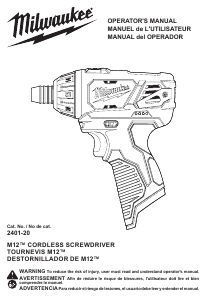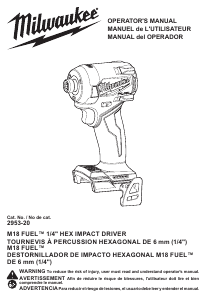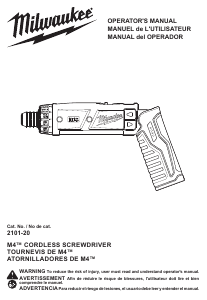
6
7
APPLICATIONS
WARNING
To reduce the risk of electric shock,
check work area for hidden pipes
and wires before drilling or driving screws.
Driving Drywall Screws
For Screwdrivers Rated up to 4300 RPM
Standard drywall screws are generally designed
for attaching drywall to wood studs and 26 through
20-gauge steel studs. MILWAUKEE Screwdrivers are
ideal for driving these types of drywall screws. The
depth setting is very important. Refer to the guide
below for the correct depth setting.
Too deep. Head of screw
punches hole in drywall
surface, making finishing
diffi cult and allowing moisture
beneath facing. Decrease
depth.
Too shallow. Head of screw
extends above drywall face
and can not be fi nished off.
Increase depth.
Correct. Head of screw is
below surface, but does not
puncture facing.
1. Select the proper drywall screw for each job. Pilot
holes are not needed. To insert screws, place the
screw onto the insert bit, then align the screw
against the work surface, making sure to hold the
tool and screw square to the work surface.
If the tool or screw are misaligned, the screw will
not drive into the work surface or it will not drive
straight.
2. Pull the trigger and push the tool forward with
a “punching” motion to sink the screw into the
drywall. A punching motion will engage the snap-
action clutch, cause the screw to start rotating,
sink the screw and disengage the snap-action
clutch within a fraction of a second. If pressure
is not maintained on the tool after engaging the
snap-action clutch, the screw will not properly seat.
The snap-action clutch will automatically disen-
gage and the insert bit will stop rotating once the
screw has been driven to the selected depth.
These screwdrivers feature a snap-action clutch,
which may ratchet slightly when the screw is sunk
to the selected depth.
NOTE: Practice driving screws into pieces of scrap
material to become familiar with the tool and the
snap-action clutch action before attempting to
drive screws into the workpiece.
3. To remove screws, remove the locator assembly
and switch the forward/reverse switch to the re-
verse position. Reattaching the locator assembly
will not change the depth setting.
Driving Decking Screws
For Screwdrivers with Depth Locators
Rated up to 2900 RPM
Standard decking screws are generally designed for
attaching wood to wood studs. MILWAUKEE Screw-
drivers are ideal for driving these types of decking
screws. The depth setting is very important. Refer to
the guide below for the correct depth setting.
Too deep. Head of screw
punches hole in surface,
allowing moisture to collect.
Decrease depth.
Too shallow. Head of screw
extends above surface.
Increase depth.
Correct. Head of screw is
below surface.
1. Select the proper decking screw for each job. Pilot
holes are not needed. To insert screws, place the
screw onto the insert bit, then align the screw
against the work surface, making sure to hold the
tool and screw square to the work surface.
If the tool or screw are misaligned, the screw will
not drive into the work surface or it will not drive
straight. Wood screws have sharp points or drill
points, and course threads that help the screw
through the wood.
2. Pull the trigger and push the tool forward to sink
the screw into the wood. A quick motion will en-
gage the snap-action clutch, cause the screw to
start rotating, sink the screw and disengage the
snap-action clutch within a fraction of a second.
If pressure is not maintained on the tool after en-
gaging the snap-action clutch, the screw will not
properly seat.
The snap-action clutch will automatically disen-
gage and the insert bit will stop rotating once the
screw has been driven to the selected depth.
These screwdrivers feature a snap-action clutch,
which may ratchet slightly when the screw is sunk
to the selected depth.
NOTE: Practice driving screws into pieces of scrap
material to become familiar with the tool and the
snap-action clutch action before attempting to
drive screws into the workpiece.
3. To remove screws, remove the locator assembly
and switch the forward/reverse switch to the re-
verse position. Reattaching the locator assembly
will not change the depth setting.
Driving Self-Drilling Screws into
Cold-Formed Steel Framing
For Adjustable Torque Screwdrivers
Rated up to 2900 RPM
Follow this procedure when working with light gauge
sheet metal, 20 gauge and thicker.
The screw may hesitate slightly when it fi nishes
breaking through the fi rst layer of material and
starts to penetrate the sheet metal. This is normal.
Keep fi rm pressure on the tool until the screw is
fully seated.
Self-drilling and self-tapping screws drill, tap and
fasten in one quick, easy motion without a separate
drilling operation. Their unique design works in metal
up to 1/2" thick, giving a strong, reliable hold. The
drill point ensures rapid drilling and consistently low
drilling pressure while the drill fl utes remove drilling
chips. The pilot section ensures that drilling is com-
pleted before the fi rst thread engages the material.
These screws can be used in many applications.
1. Insert screw into the hex socket
Corrugated siding
Wood to structure
Structure to structure
Sheet to sheet
Sheet to structure
and align the screw against
the work surface.
2. Pull the trigger while pushing
the tool forward. This motion
will engage the drive clutch,
causing the screw to start ro-
tating. If pressure is not main-
tained on the tool, the drive
clutch will disengage and the
screw will stop rotating.
When the selected torque
is fully reached, the torque
clutch will ratchet. If the
screw is not fully seated,
increase the torque setting
number until the desired
torque is obtained.
NOTE: Practice driving
screws into pieces of scrap
material to become familiar
with the tool and the clutch
action before attempting to
drive screws into the work-
piece.
3. To remove screws, switch the
forward/reverse switch to the
reverse position.
Driving Wood Screws
When driving wood screws, a pilot hole is recom-
mended to make driving easier and to prevent
splitting the wood. As a general rule, the pilot hole
should have a diameter of approximately 70% the
size of the screw diameter. Hardwood pilot holes
should have a diameter of approximately 90% the
size of the screw diameter. The depth of the pilot hole
should be shorter than the length of the screw by at
least one screw diameter. This allows the tip of the
screw to bite into the wood for extra holding power.
Counterbore the top portion of the hole for a free fi t of
the shank between the screw head and the threads.
When using fl at head screws, countersink the top of
the hole to allow the screw head to be driven fl ush
with the work surface. Use soap or wax for easier
screw insertion if necessary.
MAINTENANCE
WARNING
To reduce the risk of injury, always
unplug the tool before performing
any maintenance. Never disassemble the tool.
Contact a MILWAUKEE service facility for ALL
repairs.
Maintaining Tools
Keep your tool in good repair by adopting a regular
maintenance program. Inspect your tool for issues
such as undue noise, misalignment or binding of
moving parts, breakage of parts, or any other condi-
tion that may affect the tool operation. Return the tool
to a MILWAUKEE service facility for repair. After six
months to one year, depending on use, return the
tool to a MILWAUKEE service facility for inspection.
WARNING
To reduce the risk of personal in-
jury, electric shock and damage,
never immerse your tool in liquid or allow a liquid
to fl ow inside it.
Cleaning
Clean dust and debris from vents. Keep handles
clean, dry and free of oil or grease. Use only mild
soap and a damp cloth to clean, since certain clean-
ing agents and solvents are harmful to plastics and
other insulated parts. Some of these include gasoline,
turpentine, lacquer thinner, paint thinner, chlorinated
cleaning solvents, ammonia and household deter-
gents containing ammonia. Never use fl ammable or
combustible solvents around tools.
Repairs
For repairs, return the tool to the nearest service
center.
ACCESSORIES
WARNING
Use only recommended accesso-
ries. Others may be hazardous.
For a complete listing of accessories, go online to
www.milwaukeetool.com or contact a distributor.
SERVICE - UNITED STATES
1-800-SAWDUST (1.800.729.3878)
Monday-Friday, 7:00 AM - 6:30 PM CST
or visit www.milwaukeetool.com
Contact Corporate After Sales Service Technical
Support with technical, service/repair, or warranty
questions.
Register your tool at www.milwaukeetool.com...
• to receive important notifi cations regarding your
purchase
• to ensure that your tool is protected under the warranty
• to become a Heavy Duty club member
SERVICE - CANADA
Milwaukee Tool (Canada) Ltd
1.800.268.4015
Monday-Friday, 7:00 AM - 4:30 PM CST
or visit www.milwaukeetool.ca












Únase a la conversación sobre este producto
Aquí puedes compartir lo que piensas sobre Milwaukee 6792-20 Atornillador. Si tiene alguna pregunta, primero lea atentamente el manual. Puede solicitar un manual utilizando nuestro formulario de contacto.